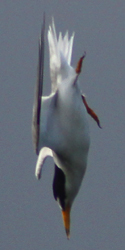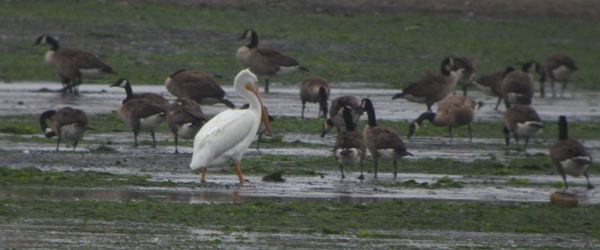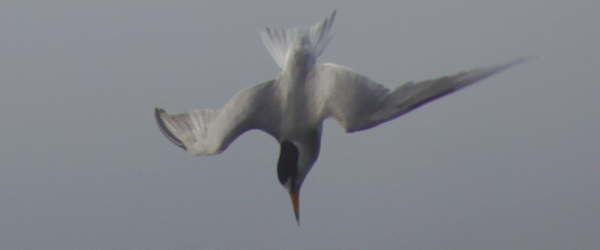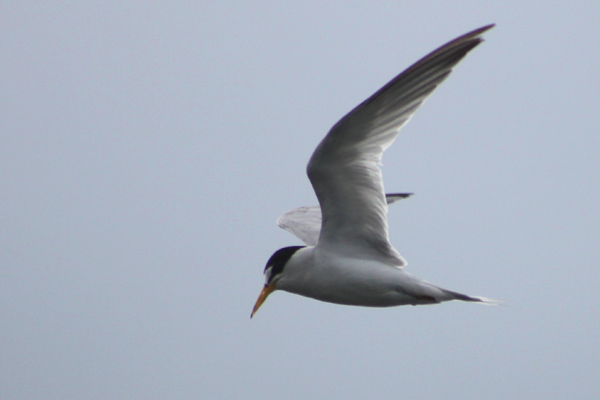There is nothing more cruel to a birder than being at work when the report of a rarity flashes across the listservs. Such was my fate on Wednesday when back-to-back reports from Jamaica Bay were posted and I could do nothing but toil for my paycheck. To be stuck breathing artificial air under artificial light with only the occasional fly by pigeon to serve as my nature fix while others were at Jamaica Bay enjoying three American Avocets and, worse yet, an American White Pelican, is the most horrific of torments. I like avocets, and have seen them at Jamaica Bay a couple of times now, but I had never seen any pelicans in New York State* ever, much less in Queens, my home borough! So the level of torture was horrific, and made worse by the fact that I was on the late shift and would never get out of work and get to Jamaica Bay in time to see the rarities.
I briefly considered feigning illness but rejected that plan as too risky. After all, if I saw the pelican I would certainly want to blog about it and at least one of my coworkers reads the blog on occasion. No, I would have to stick it out at work and try to find a way to get to the bird on Thursday morning. After dialing through my list of Queens birders with cars who might be interested I was despondent; apparently people tend to leave the city during the summer and those that remained either had other plans or had all seen the long-staying American White Pelican that showed up at Jamaica Bay a couple of years before I started birding. I would have to get up extremely early and get to the bird by mass transit and on foot, get to work via an extremely long walk, bus ride, and train ride, and torture my coworkers by stinking all day in the office. But then Danny called and let me know that he had reconsidered and wanted to go and my mood of doom and gloom turned to elation!
certainly want to blog about it and at least one of my coworkers reads the blog on occasion. No, I would have to stick it out at work and try to find a way to get to the bird on Thursday morning. After dialing through my list of Queens birders with cars who might be interested I was despondent; apparently people tend to leave the city during the summer and those that remained either had other plans or had all seen the long-staying American White Pelican that showed up at Jamaica Bay a couple of years before I started birding. I would have to get up extremely early and get to the bird by mass transit and on foot, get to work via an extremely long walk, bus ride, and train ride, and torture my coworkers by stinking all day in the office. But then Danny called and let me know that he had reconsidered and wanted to go and my mood of doom and gloom turned to elation!
I still had to get up early on Thursday morning and walk up to meet Danny but we were on our way well before 7 AM, at the Fishermen’s Parking Lot shortly thereafter, and viewing an American White Pelican that was hanging out with Canada Geese on the mudflat near the A train tracks almost as soon as we stepped from Danny’s car. Our views were distant and the bird didn’t do much besides preen and walk around a bit but it was still a pelican! In New York City! In Queens! Whoo-hoo!
Danny and I were both very happy to see the bird and drank it in for awhile before heading back to his car and driving down to the preserve proper to search for the American Avocets on the East Pond. We failed, but so did everyone else who looked for them on Thursday. They seem to have been a one-day wonder, though I still hold out hope that they might show up somewhere in the next day or so. Instead of the avocets we scoped out other shorebirds, like my first of the year Stilt Sandpipers, and watched terns fly by, especially a multitude of Least Terns which had no fear and several times dove in close proximity to where Danny and I stood rapt, loving the show. It was weird to go from one of the largest birds found on the coast to one of the smallest, but, really, it was just another example of why Jamaica Bay is one of the best birding locations in the northeastern United States.
Danny got me home with plenty of time to clean up and get to work, and I was at my desk by 10 AM, right on time. Somehow, my day in the office didn’t seem so bad after a start like I had!
*Not that pelicans don’t often turn up in New York State: they do show up pretty much at least a couple of times a year. I just had never been fortunate enough to be in the right place at the right time.
















Hmmmm, BLACK-crowned Least Tern, American White-crowned Pelican, Jamaica-crowned Bay ….
Something seems to be missing.
Nice birds though.
@Jochen: I decided that after Germany’s sad third-place finish in the World Cup that putting up more pictures of Yellow-crowned Night Herons that you will never see would be too much like rubbing salt in your wounds. So, rather than be sadistic I figured I would skip the Yellow-crowned pics until you have fully recovered and then clobber you with a gallery. 😛
@Corey: well, the World Cup wounds won’t heal until Germany has won a title. They’ve come in third or second place in so many international tournaments recently that both the team and the fans are really getting somewhat frustrated. Look at France: either they get kicked out really fast or they go ahead and win the cup. But to always get so close – yet never make it is really quite some bummer.
Having said that, I have gotten so used to agony that I feel I can stomach a Yellow-Crowned Freak-heron gallery anytime, my friend, any time!!
🙂
Come on, deliver and be done with it!!
😉
Rare bird fever is listed in the DSM, right? No?
So awesome Corey! Glad you were able to see it and nice pics of all the birds.
If anybody’s up for pelican-stalking Sunday morning, I can take a ride down to Jamaica Bay and pick up the auto-less along the way …
Good thing I already have a NYS White Pelican, or I might be a little jealous.
@Carrie: does this mean birding to you is more about the list than the bird?
🙂
Great adventure, I really wish I could travel all over (a bit low on money right now).